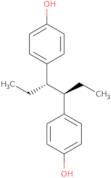Hexestrol
CAS: 84-16-2
Ref. 3D-FH23819
| 1g | Discontinued | ||
| 2g | Discontinued | ||
| 5g | Discontinued | ||
| 10g | Discontinued | ||
| 500mg | Discontinued |
Product Information
- rel-4,4'-[(1R,2S)-1,2-Diethyl-1,2-ethanediyl]bisphenol
- (R*,S*)-4,4'-(1,2-diethylethylene)bis(phenol)
- 3,4-Bis(p-hydroxyphenyl)hexane
- 4,4'-(1,2-Diethylethylene)diphenol
- Cycloestrol
- Dihydrodiethylstilbestrol
- Erythrohexestrol
- Estrifar
- Estronal
- Extra-Plex
- See more synonyms
- Hexanoestrol
- Hexestrofen
- Hexron
- Hormoestrol
- Meso-Hexestrol
- Mesohexestrol
- NSC 9894
- Phenol, 4,4′-(1,2-diethyl-1,2-ethanediyl)bis-, (R*,S*)-
- Phenol, 4,4′-(1,2-diethylethylene)di-, meso-
- Phenol, 4,4′-[(1R,2S)-1,2-diethyl-1,2-ethanediyl]bis-, rel-
- Sinestrol
- Synestrol
- Synoestrol
- Synthovo
- Syntrogene
- meso-3,4-Bis(p-hydroxyphenyl)-n-hexane
- meso-3,4-Di(p-hydroxyphenyl)-n-hexane
- rel-4,4′-[(1R,2S)-1,2-Diethyl-1,2-ethanediyl]bis[phenol]
Hexestrol is a synthetic sex hormone that is used to treat inflammatory bowel disease. It is a derivative of trenbolone and it has been shown to have antimicrobial effects against Escherichia coli, Pseudomonas aeruginosa, and Candida albicans. Hexestrol binds to the protein genes in the cell cytosol, leading to the inhibition of transcription of these genes and the synthesis of proteins. Hexestrol also interacts with the liver microsomes, which leads to an increase in lipid peroxidation and a decrease in glutathione peroxidase activity. The chemical reaction mechanism for hexestrol is not yet known.





